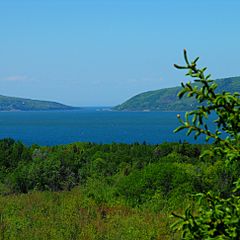Digby Gut facts for kids
The Digby Gut is a special natural channel in Nova Scotia, Canada. It connects the huge Bay of Fundy with the smaller, calmer Annapolis Basin. Imagine it like a natural doorway between two different bodies of water.
The town of Digby, Nova Scotia is located right near the Gut, on its western side. A lighthouse called Point Prim Lighthouse stands at the eastern entrance, guiding ships safely.
Contents
What Makes Digby Gut Unique?
The Digby Gut is known for its powerful tides and strong currents. The water here can move very fast, up to 5 knots (about 9 kilometers per hour)! These fast currents create swirling water, like small whirlpools and eddies, which can make sailing tricky.
Because of the strong currents, rocky areas, frequent fogs, and changing winds, passing through the Digby Gut can be challenging. Sailors often need help from an experienced local pilot who knows the waters well.
The Gut is about half a nautical mile wide (almost one kilometer). It's surrounded by tall, rocky cliffs. It also marks a break in the North Mountain ridge and is the eastern end of a land feature called Digby Neck.
How Digby Gut Formed
Long, long ago, the Digby Gut was actually the northern end of an ancient river called the Bear River. Over time, the sea level rose and filled part of this river valley with water, creating what is known as a "drowned river valley." This is how the channel we see today was formed.
Digby Gut in Daily Life and Culture
The Digby Gut is an important waterway. The Digby Pines Resort overlooks this beautiful channel. For many years, ferries have used the Gut daily to travel between Digby and Saint John, New Brunswick. Famous ferries like the SS Princess Helene and MV Princess of Acadia have sailed through here.
The Digby Gut has even inspired art! A famous Canadian poet named Bliss Carman wrote a classic poem about courage called "Arnold, Master of the Scud." It tells the story of a brave twelve-year-old sailor who sailed a schooner (a type of boat) through the Digby Gut during a storm all by himself.


